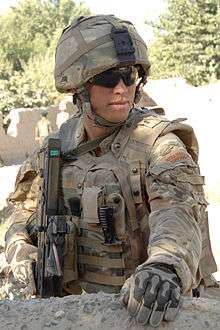Mk 7 helmet
The Mk 7 helmet is the current general issue combat helmet of the British Armed Forces supplied by NP Aerospace. Officially known as the GS (General Service) Mark 7 combat helmet. It replaced the previous Mk 6A helmet and Mk 6 helmet, introduced in 2005 and 1982 respectively.

The Mk 7 helmet was introduced in June 2009 as an UOR (urgent operational requirement). The new helmet offers the same ballistic protection as the Mk6A helmet, but its new shape allows a soldier to lie flat and shoot straight, without the rear rim digging into his body armour and tipping the front rim over his eyes.[1]
The Mk 7 helmet is lighter than its predecessor – 1 kg instead of 1.5 kg for the Mark 6 helmet – and has better chin strapping for stability. It is produced in a new colour - tan, unlike the Mk 6A in black and Mk 6 in olive. It has been adopted for use in Afghanistan.
The ballistic protection is measured with V50 and for the Mk 7 it is about 650 m/s. (V50 is the mean penetration velocity. At this velocity, half (50%) of projectiles are expected to penetrate.)
The Mk 7 helmet is being replaced by the Revision Military Batlskin Cobra Plus helmet as part of the Virtus programme.[2]
In Ukraine, in 2014, due to a lack of adequate protection for members of the Ukrainian Armed Forces participating in the War in Eastern Ukraine, hundreds of Mk 7 helmets were purchased in the UK, and used by Ukrainian servicemen; together with the earlier Mk 6 and Mk 6A. The Mk 7 helmet is extremely popular among Ukrainian military personnel, creating a high demand for it.
References
- "[ARCHIVED CONTENT] Ministry of Defence - New helmets and armour for troops in Afghanistan". Archived from the original on 2012-11-01. Retrieved 2010-11-10.
- "Revision to Supply State-of-the-Art Cobra Plus Head Protection System for UK Troops". Retrieved 2015-09-18.
External links
| Wikimedia Commons has media related to Mark VII combat helmet. |